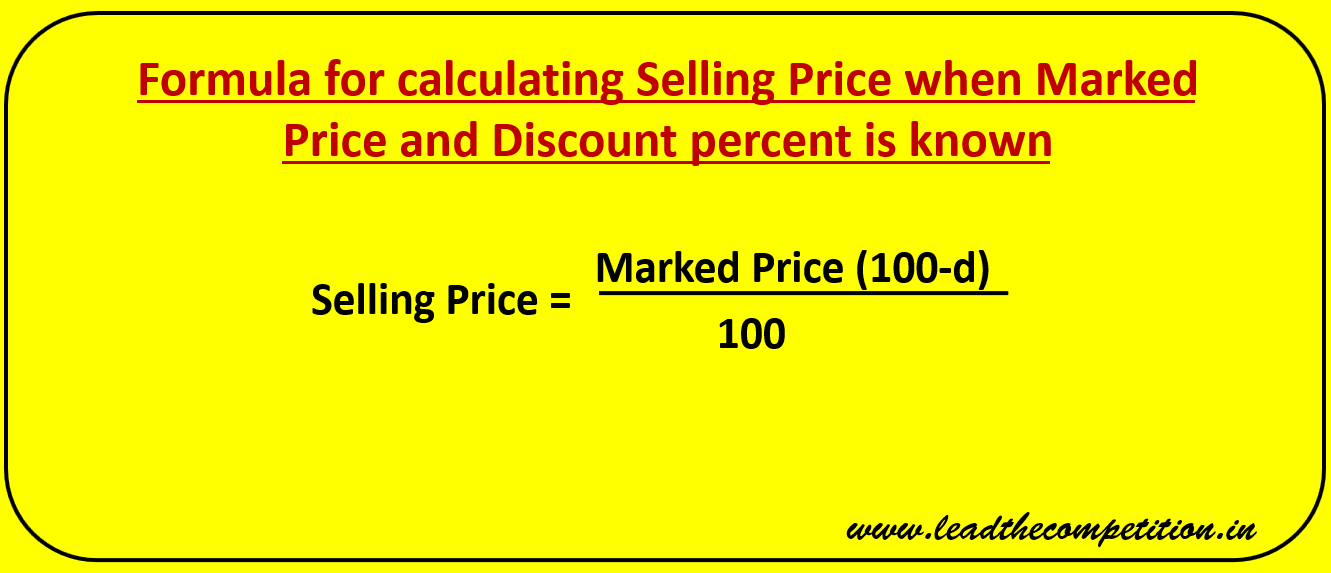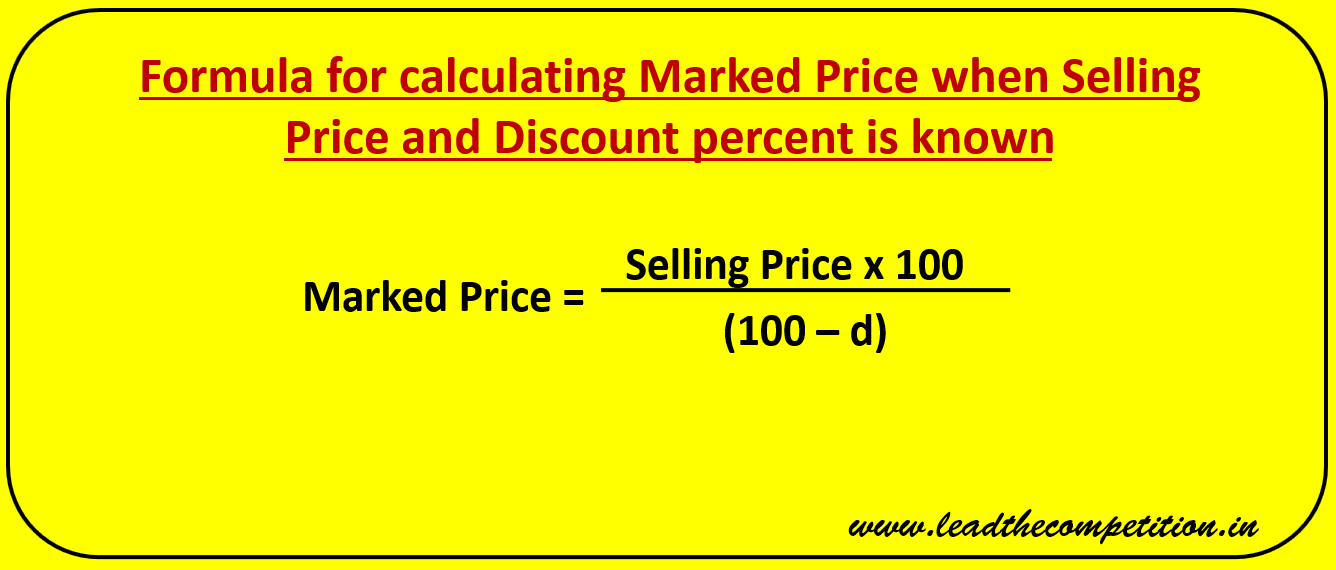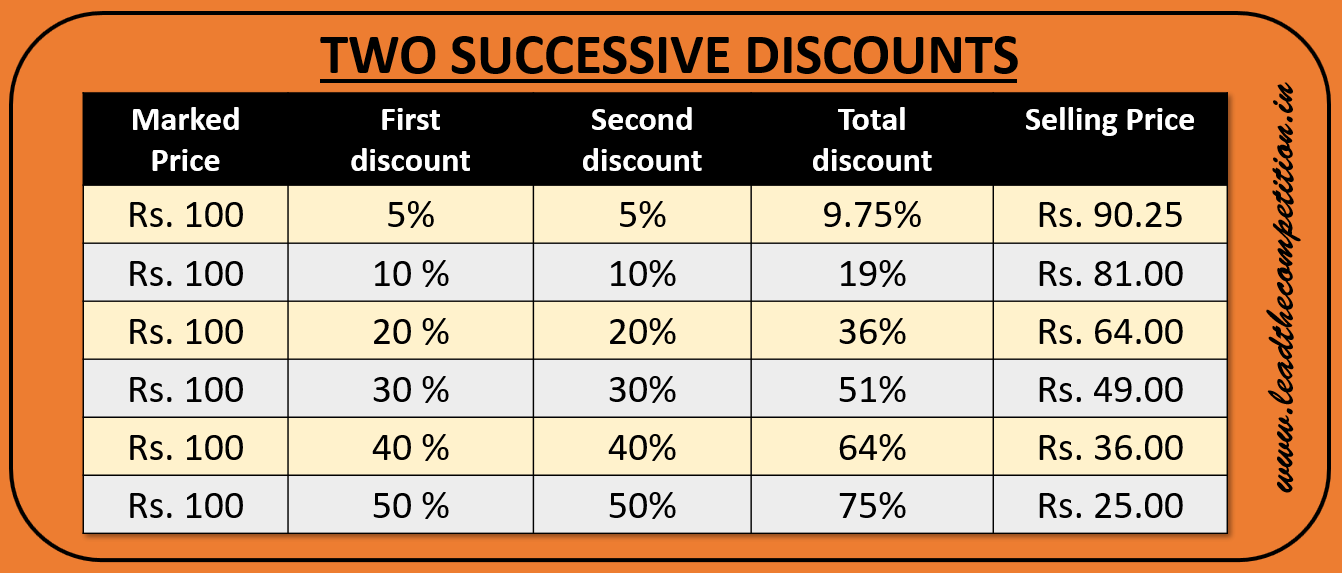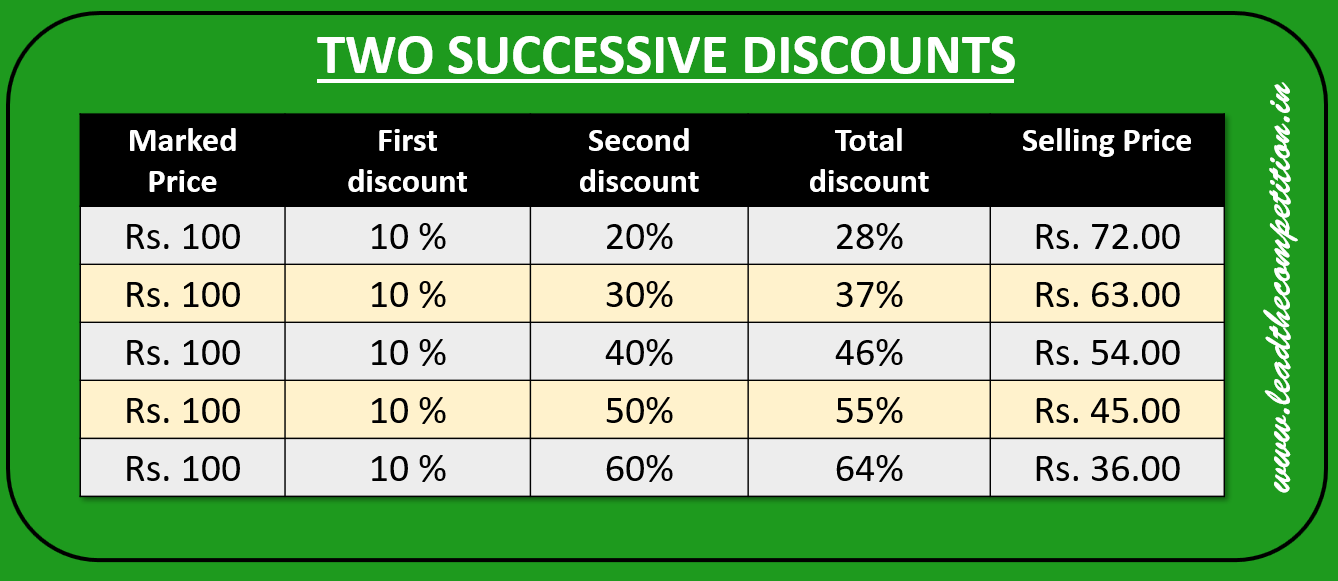PRACTICE QUESTIONS ON DISCOUNT
To Take a Practice Test on Quantitative Aptitude Click Here
This section contains a practice test of 20 questions on Discounts and about 20 model questions based on previous examinations on discounts. Practice in a time bound manner and evaluate yourself or just go through model questions and their solutions to improve your understanding of problems on discounts.
PRACTICE TEST ON DISCOUNTS
MODEL QUESTIONS ARE GIVEN BELOW THE TEST ON MOBILE SCREENS
Directions: In the questions given below, four options have been given. Click on the option which you think is the RIGHT ANSWER to the question.
Press Start to enable the test.
Reset to erase answers.
You have 20 minutes to complete the test.
If you are facing any technical issues with this page, please mail to us at admin@leadthecompetition.in
Score 0
Timer 00:00
| Question |
|---|
|
1. The successive discount of 15%, 20% and 25% on an arcile is equivalent to the single discount of |
|
2. While selling a watch, a shopkeeper gives a discount of 8%. If he gives a discount of 10%, he earns Rs. 20 less as profit. What is the marked price of the watch? |
|
3. A retailer gets a discount of 40% on the printed price of an article. The retailer sells it at the printed price. His gain percent is |
|
4. A fan is listed at Rs. 150 with a discount of 20%. What additional discount must be offered to the customer to bring the net price to Rs. 108? |
|
5. A dealer marks a washing machine for Rs. 7500 and allows a discount of 6% on it. Find the selling price. |
|
6. Two successive discounts of 10% and 20% are equivalent to a single discount of |
|
7. A shopkeeper marks his goods 50% more than the cost price and allows a discount of 25%. His profi or loss percentage is |
|
8. A merchant changed his trade discount from 25% to 15%. This would increase selling price by |
|
9. A trader marks his goods in such a way that after allowing a discount of 10% he gains 15%. If an article costs him Rs. 720, his marked price is |
|
10. The price of a chair is Rs. 500. It has been sold at two successive discounts of 10% each. What is its selling price? |
|
11. A shopkeeper earns a profit of 12% on selling a book at 10% discount on the printed price. The ratio of cost price to the printed price of the book is |
|
12. A watch is listed for Rs. 230 and is sold at a discount of 12%, then the sale price of the watch is |
|
13. A bookseller allowed 15% discount on the books sold. Sunil purchased books worth Rs. 1500. How much will he have to pay the bookseller? |
|
14. A shopkeeper allows 20% discount on the marked price of his articles. Find the marked price of an article for which he charges Rs. 740. |
|
15. A shopkeeper marks his goods 40% above the cost price and allows a discount of 25% on it. His gain % is |
|
16. Two shopkeepers announce the same price of Rs. 700 for a sewing machine. The first offers successive discounts of 30% and 6% while the second offers successive discounts of 20% and 16%. The difference in their selling prices is |
|
17. A shopkeeper earns a profit of 15% after selling a book at 20% discount on the printed price. The ratio of the cost price and printed price of the book is |
|
18. The rate of discount being given on a shirt where selling price is Rs. 546 after deducting a discount of Rs. 109 on its marked price is? |
|
19. The marked price is 10% higher than the cost price. A discount of 10% is given on the marked price. What is the profit or loss to the seller? |
|
20. A dealer marks his goods 20% above cost price. He then allows some discount on it and makes a profit of 8%. The rate of discount is |
Successive Discounts Calculator
😊 Have Fun 😊
Enter '0' if you have only 1 or 2 discount values.
MODEL QUESTIONS ON DISCOUNTS
Click on the Show Answer button to see the answer.
1. Applied to a bill for Rs. 1,00,000 the difference between a discount of 40% and two successive discounts of 36% and 4% is:
- Nil
- Rs. 1440
- Rs. 2500
- Rs. 4000

2. On a 20% discount sale, an article costs Rs. 596. What was the original price of the article?
- Rs. 720
- Rs. 735
- Rs. 745
- Rs. 775
3. A discount of 15% on one article is the same as discount of 20% on a second article. The costs of the two articles can be:
- Rs. 85, Rs. 60
- Rs. 60, Rs. 40
- Rs. 40, Rs. 20
- Rs. 80, Rs. 60

4. A discount of 2 ½% is given to the customer on marked price of an article. A man bought the article for Rs. 39. The marked price of article is:
- Rs. 40
- Rs. 36.5
- Rs. 42
- Rs. 41.5
5. Printed price of an article is Rs. 900 but the retailer gets a discount of 40%. He sells the article for Rs. 900. Retailer’s gain percent is:
- 40
- 60
- 662/3
- 681/3

6. The marked price of a watch was Rs. 720. A man bought the same watch for Rs. 550.80, after getting two successive discounts. If the first discount was 10%, what was the second discount rate?
- 12%
- 15%
- 14%
- 18%
7. A shopkeeper marks his goods 20% above cost price, but allows 30% discount for cash. His net loss is:
- 8%
- 10%
- 16%
- 20%
8. A retailer buys 40 pens at the marked price of 36 pens from a wholesaler. If he sells these pens giving a discount of 1%, what is the profit percent?
- 9%
- 10%
- 10 1/9 %
- 11%.
9. A dealer offers a discount of 10% on the marked price of an article and still makes a profit of 20%. If its marked price is Rs. 800, then the cost price of the article is:
- Rs. 900
- Rs. 800
- Rs. 700
- Rs. 600.
10. Successive discounts of 20% and 10% are equivalent to a single discount of :
- 28%
- 15%
- 30%
- 25%

11. A tradesman marks his goods 10% above his cost price. If he allows his customers 10% discount on the marked price, how much profit or loss does he make, if any?
- 1% gain
- 1% loss
- 5% gain
- No gain, no loss.
12. A product has a marked price of Rs. 100. What would be its selling price if successive discounts of 10%, 15% and 20% are given on it?
- Rs. 55
- Rs. 56.40
- Rs. 61.20
- Rs. 67.80
13. A trader purchases an item for Rs. 540 and sets it marked price at 20% above the cost price. He then sells it at a discount of 10% on the marked price. What is his profit percentage?
- 10%
- 12%
- 15%
- 8%
14. If after two successive discounts of 20% and 35%, an item is sold for Rs. 5200, what is its marked price?
- Rs. 10,000
- Rs. 9,800
- Rs. 9,000
- Rs. 8,000
15. A trader marks his goods at 50% above the cost price and sells half of the items after offering a discount of 20%. Later he marks his goods at 60% above the cost price and sells the left over half offering the same discount of 20%. What is his profit percent in all?
- 20%
- 24%
- 25%
- 30%
16. A trader offers 1 T-shirt free with each T-shirt purchased at the marked price. If he still makes a profit of 20%, at what percentage above the cost price has the trader set the marked price?
- 100%
- 120%
- 150%
- 200%

17. A retailer is offered 2 free sarees for every bundle of 10 sarees he purchases from the wholesaler. He wants to offer 1 saree free for every 2 sarees purchased but still make a profit of 10%. At what percent above the cost price should he set the marked price?
- 110%
- 125%
- 140%
- 165%
18. If the cost price of an article is 75% of its marked price and the trader allows a discount of 20% on the marked price, what is his gain or loss percent?
- 5% gain
- 6.66% gain
- 5% loss
- No loss no gain
19. On a marked price of Rs. 250, a shopkeeper offers successive discounts of 10%, 15% and 20% while his neighbour offers successive discounts of 20%, 15% abd 10%. Who sells it for lesser price?
- The first trader
- The second trader
- Both sell at the same price
- None of the above
20. A customer is offered 20% discount on purchase of an item but after billing, he notices that he has been given a discount of only 10%. The shopkeeper then returns 10% of the bill amount. How much did the customer lose or gain?
- Neither gained nor lost
- Gained 1%
- Lost 1%
- Lost 2%